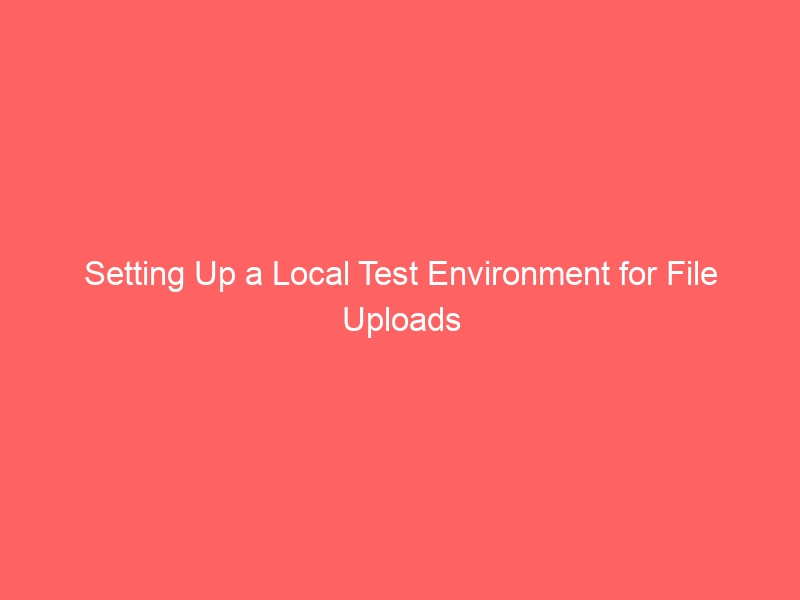Testing file uploads is a fundamental part of web development, but doing it directly on a live server is risky and inefficient. A **local test environment** provides a safe, controlled sandbox where you can experiment with file uploads, test different file types and sizes, and debug issues without affecting your production system. Here’s how to set up a basic environment.
Why a Local Environment is Crucial for Upload Testing
- Safety First: Avoid accidentally uploading malicious files or exceeding limits on a live server.
- Faster Iteration: Changes are immediate, and you don’t depend on network latency for uploads.
- Isolation: Test features without impacting other users or live data.
- Debugging: Easier to inspect server logs, network requests, and code behavior locally.
- Cost-Effective: No hosting costs associated with your development and testing.
Method 1: Simple PHP Server (Quick & Easy)
If you primarily work with PHP, Python, or Node.js, you can spin up a simple local server quickly.
For PHP:
Create an index.php file with a basic upload form:
<?php
if (isset($_FILES['test_file'])) {
$target_dir = "uploads/";
$target_file = $target_dir . basename($_FILES["test_file"]["name"]);
if (!is_dir($target_dir)) {
mkdir($target_dir, 0777, true);
}
if (move_uploaded_file($_FILES["test_file"]["tmp_name"], $target_file)) {
echo "<p style='color: green;'>File ". htmlspecialchars(basename($_FILES["test_file"]["name"])) . " uploaded successfully!</p>";
} else {
echo "<p style='color: red;'>Error uploading file.</p>";
}
}
?>
<!DOCTYPE html>
<html>
<head><title>File Upload Test</title></head>
<body>
<h3>Upload a Test File</h3>
<form action="" method="post" enctype="multipart/form-data">
Select file to upload:
<input type="file" name="test_file" id="test_file">
<input type="submit" value="Upload File" name="submit">
</form>
</body>
</html>
Save this as `index.php` in a folder (e.g., `my-upload-test`). Open your terminal in that folder and run:
php -S localhost:8000Then, navigate to `http://localhost:8000` in your browser.
Method 2: Using XAMPP/WAMP (Full Local Server Stack)
For more robust local development (with Apache, MySQL, PHP/Perl), XAMPP (Windows, Linux, macOS) or WAMP (Windows) are excellent choices. They provide a full server stack on your local machine.
- Download & Install: Get XAMPP from Apache Friends (apachefriends.org).
- Start Servers: After installation, start Apache and MySQL from the XAMPP control panel.
- Place Your Files: Put your web project (like the PHP upload script above) into the `htdocs` folder inside your XAMPP installation directory.
- Access: Open your browser and go to `http://localhost/your_project_folder/`.
XAMPP/WAMP environments are perfect for testing WordPress installations, custom PHP applications, and more complex file handling scenarios, including database interactions.
Method 3: Docker (Containerized & Isolated)
For highly isolated and reproducible environments, Docker is a powerful option. You can spin up containers with specific web server configurations.
Example Dockerfile for a simple Nginx + PHP-FPM setup:
# Dockerfile
FROM php:7.4-fpm
RUN apt-get update && apt-get install -y nginx
COPY ./nginx.conf /etc/nginx/sites-available/default
COPY ./index.php /var/www/html/index.php
WORKDIR /var/www/html
EXPOSE 80
CMD service nginx start && php-fpm
This requires a simple `nginx.conf` and your `index.php`. Docker gives you ultimate control over the environment and ensures consistency across different development machines.
Using Our Dummy Files in Your Local Setup
Once your local environment is ready, you can start using our dummy test files. Download different sizes and formats (e.g., 1MB EXE, 50MB PDF, 250MB MP4) and upload them through your local form. Observe server responses, check file sizes in your designated upload directory, and fine-tune your application’s file handling logic.
Setting up a robust local test environment is an investment that pays off significantly in terms of development speed, code quality, and peace of mind.
Ready to get started? Download our dummy files and put your local environment to the test!
